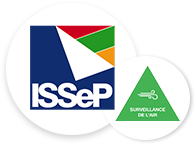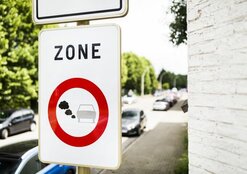In the article:
The project
In January 2019, in order to improve air quality, the Walloon Parliament adopted a decree on combatting air pollution linked to vehicle traffic. One of the measures of this decree is the option for municipalities to establish low emission zones (LEZ) across their region from 2020.
Inside an LEZ, access by the most polluting vehicles will gradually be prohibited depending on the engine type (diesel engine, petrol engine, etc.) and the European emissions standard (European Union regulation that sets the maximum pollutant discharge limits for new vehicles). The phase-out schedule is available at https://www.wallonie.be/fr/actualites/vers-la-fin-des-vehicules-les-plus-polluants-en-wallonie.
Under the Wallonia Environment-Health Plan, the Air Quality Unit of the ISSeP is responsible for estimating the environmental impact of the introduction of municipal low emission zones by combining on site pollutant concentration measurements with air quality modelling on a municipal scale. The municipalities of Namur and Eupen have acted as pilot cities for this study.
The project report is available on the ISSeP website https://www.issep.be/wp-content/uploads/Projet-ZBE.pdf.
The final report of the "2ZBE" study on the usefulness of introducing municipal low emission zones, including all the results and conclusions of this research, is available in the "Publications" section.
The modelling
Predictions of concentrations of PM10 (fine particles less than 10 micrometers in diameter), PM2.5 (fine particles less than 2.5 micrometers in diameter), BC (black carbon) and NO2 (nitrogen dioxide) were made using the ATMO-Street model as part of the 2ZBE project (The project). This high spatial resolution mapping (10 metres) of air quality in Namur and Eupen was used to estimate the environmental impact of the introduction of a low emission zone in both these municipalities.
Air quality projections in 2018
ATMO-Street simulated the whole of 2018 at a one-hour time resolution. The meteorological conditions (wind, temperature and solar radiation) and background concentrations used were therefore those measured in 2018 in Namur and Eupen. The maps presented are the annual average concentrations of the four pollutants studied. The 2017 data of the Vehicle Registration Directorate (DIV) and the corresponding COPERT IV emission factors were used to define a reference vehicle fleet.
In Namur, the modelling shows that, in several places, the population is exposed to high levels of pollution that do not fall within the limit values set by the European Union. With regard to NO2, the limit value of 40 μg/m3 for the annual average was exceeded mainly on regional roads, thoroughfares that serve the city or form the belt around the Corbeille, but also on smaller, urban canyon-type streets in the city centre.
In Eupen, concentrations were only really critical on the outskirts of the city centre during the morning and evening rush hours.
Air quality projections with the introduction of an LEZ
Projections of the impact of an LEZ on pollution levels in 2020, 2022 and 2025 incorporate the emission reductions expected from the phased bans on older vehicles (https://www.wallonie.be/fr/actualites/vers-la-fin-des-vehicules-les-plus-polluants-en-wallonie). These projections were made using 2018 meteorological conditions. Keeping a base weather year allows the effect of reduced road emissions on concentrations to be isolated, but it is important to remember that concentrations can vary greatly depending on the weather.
Emission reductions were calculated using the 2017 Walloon fleet as a reference. All vehicles in the Walloon fleet, regardless of whether they are affected by the bans, are taken into account in the calculation of emissions in 2017 and the expected emissions reductions in 2020, 2022 and 2025. For each stage in the phase-out schedule, the banned vehicles are replaced by Euro 6 vehicles in our forecasts and the size of the vehicle fleet does not change. The number of kilometres travelled by each category of vehicle is also assumed to remain the same.
In both Namur and Eupen, model projections with the introduction of a low emission zone show mixed results. The expected reductions are low for two pollutants for which standards have to be met: NO2 (up to 26% reduction in 2025) and fine particles (no more than 10% reduction in 2025). However, a municipal low emission zone would have a significant impact on the concentrations of a pollutant for which no standard yet exists, black carbon, which is closely linked to road traffic. For black carbon, reductions in concentrations in Namur could reach 60% by 2025, compared to 2018 concentration levels.
The final report of the "2ZBE" study on the usefulness of introducing municipal low emission zones, including all the results and conclusions of this research, is available in the "Publications" section.








